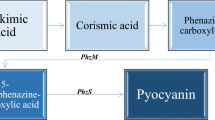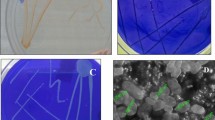Abstract
Color is the most prominent factor in any marketable product. Among microorganisms, Pseudomonas spp. produces four different types of pigments. The aim of this study is biosynthesis and optimization of pyoverdine from locally isolated Pseudomonas aeruginosa. Response surface methodology (RSM) was used to optimize two growth parameters, i.e., temperature (30–40 ℃) and pH (5–8). RSM predicted maximum yield of pyoverdine at pH 7 and temperature 37℃. Optimal growth media and incubation time required for pigment production was analyzed by spectroscopy. For this, three culture media (nutrient broth, King’s B, and synthetic citrate media) were inoculated with P. aeruginosa and incubated at 37℃ for 24–120 h. Maximum optical density 1.94 (in nutrient broth) at 420 nm indicated maximum production of pyoverdine, and time recorded for maximum production was 120 h. Growth of P. aeruginosa on nutrient broth, pH 7, incubation time 120 h at 37℃ yielded 2.5 g/L pyoverdine; that was extracted using chloroform. Spectroscopic analysis revealed presence of a chromophore that emits maximum light at 400 nm and thin-layer chromatography performed using n-butanol, acetic acid, and water 3:2:1 as solvent system indicated exhibition of florescent under UV lamp of 354 nm. Amine stretch (3232.46 cm−1), carboxyl group (1628 cm−1), and amide group (1402 cm−1) were indicated by FT-IR, and peaks obtained from NMR spectra at 7.888 ppm, 7.1 ppm, and 7.26 ppm represent 1.6 proton of aromatic chain H-4, H-5, and H-8 chromophore 3a that has been derived from 2,3-diamino-hydroxyquinoline. All of these findings demonstrate that Pseudomonas aeruginosa has the capacity to manufacture pyoverdine under the aforementioned ideal cultivation circumstances.








Similar content being viewed by others
Data availability
All the data generated in this research work has been included in this manuscript.
References
Zaujan NAM, Othman MZ, Lutfi FNM, Rahim K, Kamarudin HMN, Rehan MM (2019) Identification and characterization of pigmented bacteria isolated from Malaysian seawater. Int J Stud’ Res Technol Manag 7(4):01–08. https://doi.org/10.18510/ijsrtm.2019.741
Madadi E, Mazloum-Ravasan S, Yu JS, Ha JW, Hamishehkar H, Kim KH (2020) Therapeutic application of betalains: a review. Plants 9(9):1219
Dell’Anno F, Vitale GA, Buonocore C, Vitale L, Palma Esposito F, Coppola D, Della Sala G, Tedesco P, de Pascale D (2022) Novel insights on pyoverdine: from biosynthesis to biotechnological application. Int J Mol Sci 23(19):11507
Silva GAd, Almeida EAd (2006) Production of yellow-green fluorescent pigment by Pseudomonas fluorescens. Braz Arch Biol Technol 49:411–419
Ribeiro M, Sousa CA, Simões M (2022) Harnessing microbial iron chelators to develop innovative therapeutic agents. J Adv Res 39:89–101
Kang D, Kirienko DR, Webster P, Fisher AL, Kirienko NV (2018) Pyoverdine, a siderophore from Pseudomonas aeruginosa, translocates into C. elegans, removes iron, and activates a distinct host response. Virulence 9(1):804–817
Ringel MT, Brüser T (2018) The biosynthesis of pyoverdines. Microb cell 5(10):424
Edberg F, Kalinowski BE, Holmström SJ, Holm K (2010) Mobilization of metals from uranium mine waste: the role of pyoverdines produced by Pseudomonas fluorescens. Geobiology 8(4):278–292
Hamza EH, El-Shawadfy AM, Allam AA, Hassanein WA (2023) Study on pyoverdine and biofilm production with detection of LasR gene in MDR Pseudomonas aeruginosa. Saudi J Biol Sci 30(1):103492
Khasheii B, Mahmoodi P, Mohammadzadeh A (2021) Siderophore: a suitable candidate for drug delivery using the Trojan Horse strategy. Med Lab J 15(5):44–54
Liu Y, Dai C, Zhou Y, Qiao J, Tang B, Yu W, Zhang R, Liu Y, Lu S-E (2021) Pyoverdines are essential for the antibacterial activity of Pseudomonas chlororaphis YL-1 under low-iron conditions. Appl Environ Microbiol 87(7):e02840-e2820
Coico R (2006) Gram Staining. Curr Protocol Microbiol A–3C
Zameer M, Tahir U, Khalid S, Zahra N, Sarwar A, Aziz T, Saidal A, Alhomrani M, S Alamri A, Dablool AS, Sameeh MY, Mohamed AA, Alharbi A (2023) Isolation and characterization of indigenous bacterial assemblage for biodegradation of persistent herbicides in the soil. Acta Biochim Pol 31;70(2):325–334. https://doi.org/10.18388/abp.2020_6563
Hassen W, Neifar M, Cherif H, Najjari A, Chouchane H, Driouich RC, Salah A, Naili F, Mosbah A, Souissi Y (2018) Pseudomonas rhizophila S211, a new plant growth-promoting rhizobacterium with potential in pesticide-bioremediation. Front Microbiol 9:34
Unni KN, Priji P, Geoffroy VA, Doble M, Benjamin S (2014) Pseudomonas aeruginosa BUP2—a novel strain isolated from malabari goat produces Type 2 pyoverdine. Adv Biosci Biotechnol 5(11):874
Peekate LP, BatomBari S, Nice P (2018) Research Article Comparing the Efficacy of Kings B, Cetrimide and chloramphenicolnutrient agar medium in the isolation of Pseudomonas species. Asian J Biol Sci 11:145–151
DeBritto S, Gajbar TD, Satapute P, Sundaram L, Lakshmikantha RY, Jogaiah S, Ito S-I (2020) Isolation and characterization of nutrient dependent pyocyanin from Pseudomonas aeruginosa and its dye and agrochemical properties. Sci Rep 10(1):1–12
Biyyani Suman A, Vijaya Gopal R, Reddy S, Triveni S (2016) Isolation and characterization of Pseudomonas fluorescens in the rice rhizospheric soils of Rangareddy district in Telangana state. Int J Microbiol Res Rev 5(1):164–169
Molina L, Rosa RL, Nogales J, Rojo F (2019) Pseudomonas putida KT2440 metabolism undergoes sequential modifications during exponential growth in a complete medium as compounds are gradually consumed. Environ Microbiol 21(7):2375–2390
Casanovas-Massana A, Lucena F, Blanch AR (2010) Identification of Pseudomonas aeruginosa in water-bottling plants on the basis of procedures included in ISO 16266: 2006. J Microbiol Methods 81(1):1–5
Murugappan R, Aravinth A, Rajaroobia R, Karthikeyan M, Alamelu M (2012) Optimization of MM9 medium constituents for enhancement of siderophoregenesis in marine Pseudomonas putida using response surface methodology. Indian J Microbiol 52(3):433–441
Hussein KA, Joo JH (2017) Stimulation, purification, and chemical characterization of siderophores produced by the rhizospheric bacterial strain Pseudomonas putida. Rhizosphere 4:16–21
Bagherzade G, Tavakoli MM, Namaei MH (2017) Green synthesis of silver nanoparticles using aqueous extract of saffron Crocus sativus L. wastages and its antibacterial activity against six bacteria. Asian Pac J Trop Biomed 7(3):227–233
Sunitha I, Rao S, Ayyanna C (1998) Optimization of medium constituents and fermentation conditions for the production of L-glutamic acid by the coimmobilized whole cells of Micrococcus glutamicus and Pseudomonas reptilivora. Bioprocess Eng 18(5):353–359
Dorrestein PC, Poole K, Begley TP (2003) Formation of the chromophore of the pyoverdine siderophores by an oxidative cascade. Org Lett 5(13):2215–2217
Abd El-Ghany MN, Hamdi SA, Elbaz RM, Aloufi AS, El Sayed RR, Ghonaim GM, Farahat MG (2023) Development of a microbial-assisted process for enhanced astaxanthin recovery from crab exoskeleton waste. Fermentation 9(6):505
Demange P, Wendenbaum S, Linget C, Mertz C, Cung MT, Dell A, Abdallah MA (1990) Bacterial siderophores: structure and NMR assignment of pyoverdins Pa, siderophores of Pseudomonas aeruginosa ATCC 15692. Biol Met 3(3):155–170
Kolasa T (1983) The conformational behaviour of hydroxamic acids. Tetrahedron 39(10):1753–1754
Ullah, N, Mujaddad-ur-Rehman M, Sarwar A, Muhammad N, Rubina N, Muhammad I, Idrees M, Urooj A, Sumaira N, Aziz T. (2023). Effect of bioprocess parameters on alkaline protease production by locally isolated Bacillus cereus AUST-7 using tannery waste in submerged fermentation. Biomass Conv. Bioref 1-11
Aziz T, Shah Z, Sarwar A, Ullah N, Ayaz AK. (2023). Production of bioethanol from pretreated rice straw, an integrated and mediated upstream fermentation process. Biomass Conv Bioref 1–11
Narjis K, Najeeb U, Abid S, Tariq A, Metab A, Abdulrahman A (2023) Isolation and identification of protease producing bacillus strain from cold climate soil and optimization of its production by applying different fermentation conditions. Appl Ecol Environ Res 21(4):3391–3401
Ullah N, Rehman MU, Sarwar A, Nadeem M, Nelofer R, Shakir HA, Irfan M, Idrees M, Naz S, Nabi G, Sana S, Tariq A, Metab A, Abdulrahman A, Faleh A (2022) Fermentation 8(11):628
Acknowledgements
The authors greatly acknowledge and express their gratitude to the Researchers Supporting Project number (RSP2023R335), King Saud University, Riyadh, Saudi Arabia.
Author information
Authors and Affiliations
Contributions
Conceptualization: T.G, M.U.H, N.U, M.H, and A.S.; methodology: T.G, M.U.H, N.U, M.H, and A.S..; software: T.A. and A.A.S.; validation: N.U.; formal analysis: T.A.; investigation: M.A; N.U, and A.A.K.; resources: A.S.A and M.A.; data curation: A.S.; writing—original draft preparation: T.A and A.S.; writing—review and editing: T.A, and T.A; visualization: N.U, and A.A.S.; supervision: M.A and A.F.A.; project administration: T.A.; funding acquisition: T.A and M.A.
Corresponding author
Ethics declarations
Ethical approval
Not applicable.
Competing interests
The authors declare no competing interests.
Additional information
Publisher's Note
Springer Nature remains neutral with regard to jurisdictional claims in published maps and institutional affiliations.
Supplementary Information
Below is the link to the electronic supplementary material.
Rights and permissions
Springer Nature or its licensor (e.g. a society or other partner) holds exclusive rights to this article under a publishing agreement with the author(s) or other rightsholder(s); author self-archiving of the accepted manuscript version of this article is solely governed by the terms of such publishing agreement and applicable law.
About this article
Cite this article
Gillani, T., Mahmood-Ul-Hassan, Ullah, N. et al. Optimization of pyoverdine pigment biosynthesis conditions from a locally isolated strain of Pseudomonas aeruginosa. Biomass Conv. Bioref. (2023). https://doi.org/10.1007/s13399-023-04855-w
Received:
Revised:
Accepted:
Published:
DOI: https://doi.org/10.1007/s13399-023-04855-w




